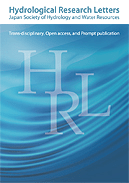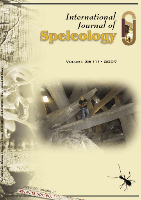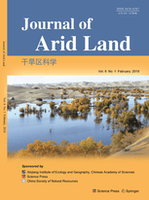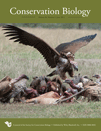
JOURNAL OF CAVE AND KARST STUDIES
metrics 2024
Illuminating the Mysteries Beneath Our Feet
Introduction
JOURNAL OF CAVE AND KARST STUDIES, published by the NATIONAL SPELEOLOGICAL SOCIETY, stands as a leading academic platform dedicated to advancing knowledge in the field of cave and karst studies. Since its inception in 1996, this journal has consistently provided high-quality research articles that explore the geological, biological, and hydrological processes associated with these unique environments. With an impact factor that situates it in the Q3 category of Earth-Surface Processes, indexed by Scopus, it ranks 97th out of 179 journals in this domain, reflecting its contribution to the field. Although open access is not currently offered, the journal's rigorous peer-review process ensures scholarly integrity and quality. Researchers, professionals, and students around the globe are encouraged to engage with the journal for the latest insights and breakthroughs, fostering a greater understanding of cave and karst ecosystems. For more information, please refer to their address in Huntsville, AL, or visit their official website for submissions and guidelines.
Metrics 2024
 0.20
0.20 0.50
0.50 0.70
0.70 47
47Metrics History
Rank 2024
Scopus
IF (Web Of Science)
JCI (Web Of Science)
Quartile History
Similar Journals

Hydrological Research Letters
Empowering Research: Navigating the Waters of DiscoveryHydrological Research Letters (ISSN: 1882-3416) is a distinguished peer-reviewed journal published by JSHWR, JAGH, JAHS, JSPH in Japan. Established with open access since 2007, this journal serves as a critical platform for the dissemination of innovative research in the field of hydrology, water science, and technology. With an increasing impact factor, currently positioned in the Q3 quartile for both Earth and Planetary Sciences and Water Science and Technology, it attracts a diverse readership keen to stay abreast of groundbreaking findings that shape water management and environmental policy. Researchers, professionals, and students alike will find this publication an invaluable resource for enhancing their understanding of hydrological processes and their implications. The journal is committed to fostering open academic dialogue and encouraging high-quality contributions during its converging years from 2015 to 2024. For more information, authors and readers can access the journal at its address, C/O INT ACAD PRINTING CO, LTD, Shinjuku-ku, Tokyo, Japan.

WETLANDS ECOLOGY AND MANAGEMENT
Illuminating the dynamics of aquatic ecosystems for a sustainable future.Wetlands Ecology and Management, published by Springer, is an esteemed journal that has been advancing the field of wetland studies since its inception in 1982. Operating under the ISSN 0923-4861 and E-ISSN 1572-9834, this journal is headquartered in the Netherlands and serves as a critical resource for researchers, professionals, and students alike. It fosters interdisciplinary dialogue among aquatic science, ecology, and resource management disciplines, ranking in the Q2 category for Aquatic Science and Ecology, Evolution, Behavior and Systematics as of 2023. With a notable Scopus ranking, it is positioned favorably within the 65th percentile in Ecology and a commendable 58th percentile in Aquatic Sciences. The journal emphasizes the importance of effective management strategies and policies in the conservation of wetlands, making it indispensable for those aiming to drive impactful research. Although it is not an open-access journal, its high-quality publications remain accessible through library consortia and institutional subscriptions, ensuring that pertinent insights into the ecological dynamics and sustainable management practices are available to the global research community.

INTERNATIONAL JOURNAL OF SPELEOLOGY
Connecting Scholars in the World of GeosciencesINTERNATIONAL JOURNAL OF SPELEOLOGY, an esteemed publication from the SOCIETA SPELEOLOGICA ITALIANA, stands at the forefront of research in the fields of Earth-Surface Processes and Geology. With an ISSN of 0392-6672 and an E-ISSN of 1827-806X, this Open Access journal has been dedicated to promoting scholarly work since 2002, facilitating broad dissemination of knowledge and research breakthroughs globally. Based in the vibrant city of Bologna, Italy, the journal covers an extensive range of topics pertinent to both speleology and the geological sciences. Notably, it is ranked in the Q2 category in both Earth-Surface Processes and Geology as of 2023, placing it among the top publications in these fields (Scopus Rank: #114/321 in Geology and #73/179 in Earth-Surface Processes). Researchers, professionals, and students alike can access a wealth of peer-reviewed articles that provide insights into the latest findings and methodologies in cave science and related geoscientific disciplines, reinforcing its reputation as a critical resource for advancing our understanding of subsurface environments.

Ecosistemas
Fostering biodiversity insights and ecological innovation.Ecosistemas is a prominent Open Access journal published by the ASOCIACION ESPANOLA ECOLOGIA TERRESTRE, specializing in the field of ecology. Since its inception in 2001, it has dedicated itself to advancing ecological knowledge and research, fostering an inclusive platform for the dissemination of cutting-edge studies that span ecological interactions, sustainability, and biodiversity. The journal, based in Spain, has established its reputation with notable rankings such as Q3 in the field of Ecology and Q4 in Ecology, Evolution, Behavior, and Systematics, reflecting its commitment to quality research. With a Scopus Ranks position placing it in the 40th and 37th percentiles for its categories, Ecosistemas is integral to the academic community, serving researchers, professionals, and students alike. It provides a vital resource for those seeking to understand ecological dynamics and environmental challenges, facilitating open access to important findings and discussions that shape the future of our ecosystems.

Journal of Arid Land
Advancing knowledge for a resilient future in arid lands.Journal of Arid Land, published by SPRINGER HEIDELBERG, is a pivotal platform dedicated to advancing knowledge in the fields of Earth-Surface Processes, Management, Monitoring, Policy and Law, and Water Science and Technology. With an ISSN of 1674-6767 and an E-ISSN of 2194-7783, this journal stands out as a prominent source of scholarly research focusing on the unique challenges and opportunities of arid and semi-arid environments, particularly relevant in the context of global climate change. As of 2023, it holds a commendable Q2 ranking in several critical categories, underscoring its impact in environmental science and related disciplines. The journal, which has been in publication since 2009 and is set to continue through 2024, provides unrestricted access to high-quality research that sheds light on sustainable practices and effective policies. With its focus on arid lands, the Journal of Arid Land plays an essential role in fostering interdisciplinary dialogue among researchers, practitioners, and policymakers striving to address the pressing issues faced by these ecosystems.

LIMNETICA
Exploring the depths of freshwater ecosystems.LIMNETICA is a prestigious academic journal dedicated to advancing the field of Aquatic Science, Ecology, and Water Science and Technology. Published by the Asociación Española de Limnología in Spain, this journal serves as a vital platform for researchers and professionals seeking to share their findings and insights from 1996 to 2024. With a commendable Q2 ranking in Ecology and notable Q3 rankings in Aquatic Science and Water Science and Technology, LIMNETICA emphasizes high-quality, peer-reviewed research that contributes to our understanding of freshwater ecosystems. Although currently not classified under Open Access, its rigorous indexing and Scopus rankings—positioning it in the top 64th percentile for Environmental Science—illustrate its impact in the scientific community. Researchers, students, and professionals are encouraged to engage with LIMNETICA to stay abreast of key developments and foster collaborative efforts in aquatic research.

CARBONATES AND EVAPORITES
Unveiling the Secrets of Earth’s Geological FormationsCARBONATES AND EVAPORITES is a distinguished peer-reviewed journal published by Springer, with a dedicated focus on the geochemical and petrological aspects of carbonates and evaporite minerals. Since its inception in 1986, the journal has served as a vital platform for disseminating high-quality research, contributing significantly to the understanding of these essential geological formations. With an impressive Scopus ranking in the 49th percentile and categorized in the Q3 quartile for Geochemistry and Petrology in 2023, it stands as a credible source for both researchers and professionals in the field. The journal is committed to publishing original research articles, reviews, and technical notes that enhance knowledge and foster discussion in the community. Although not an open-access publication, it continues to provide critical insights and findings that influence advancements in Earth and planetary sciences. Operating from its base in Germany, the journal is poised for continued relevance as it approaches the convergence year of 2024, inviting contributions that explore the richness of carbonate and evaporite studies.

ACTA CARSOLOGICA
Fostering Collaboration in Karst Research and BeyondACTA CARSOLOGICA is an esteemed open-access journal published by the KARST RESEARCH INSTITUTE ZRC SAZU in Slovenia, dedicated to advancing knowledge in the field of Earth-Surface Processes. Since its inception in 1981, and with an open-access model adopted in 2012, this journal has provided a vital platform for researchers to disseminate their findings and engage with the global scientific community. With an impact factor reflecting its scholarly contribution and a placement in the Q3 quartile of its category as of 2023, ACTA CARSOLOGICA is positioned among notable journals in Earth and Planetary Sciences. The journal plays a crucial role in facilitating discussions on karst and related environments, making it an essential resource for academics, professionals, and students interested in environmental processes and geosciences. Its comprehensive coverage of converged topics and ongoing research developments underscores its significance in promoting scientific inquiry and fostering academic collaboration.

GEOSCIENCES JOURNAL
Exploring Earth's Mysteries, One Article at a Time.Welcome to the GEOSCIENCES JOURNAL, a pivotal publication in the fields of Earth and Planetary Sciences and Environmental Science, proudly presented by the Geological Society of Korea. Established in 1997, this journal has become a prominent platform for researchers, professionals, and students, offering a rich collection of peer-reviewed articles that explore a diverse array of geoscientific topics. With an impressive Q2 ranking in both Earth and Planetary Sciences and Environmental Science categories for 2023, it stands as an essential resource in the academic community. Though it operates under a traditional subscription model, GEOSCIENCES JOURNAL remains dedicated to advancing knowledge through rigorous research. Addressed from its headquarters in Seoul, South Korea, the journal aims to foster a deeper understanding of geosciences, encouraging innovation and collaboration in tackling today’s environmental challenges.

CONSERVATION BIOLOGY
Advancing ecological insights for a sustainable future.CONSERVATION BIOLOGY, published by Wiley, is a leading journal in the field of ecology and conservation, with a focus on disseminating high-quality research that addresses pressing environmental challenges. With a strong impact factor and categorized in the top quartile (Q1) across various relevant fields including Ecology, Evolution, Behavior and Systematics, and Nature and Landscape Conservation, the journal plays a pivotal role in advancing the scientific understanding of biodiversity and conservation practices. Since its establishment in 1987, CONSERVATION BIOLOGY has provided a vital platform for researchers, professionals, and students to share innovative findings and facilitate discussions surrounding ecological sustainability and conservation strategies. Although it is not an open-access publication, it ensures that a wide range of significant research is accessible to the global scientific community. The journal’s rigorous peer-review process and reputation for excellence make it an essential resource for anyone involved in the study of ecology and conservation.